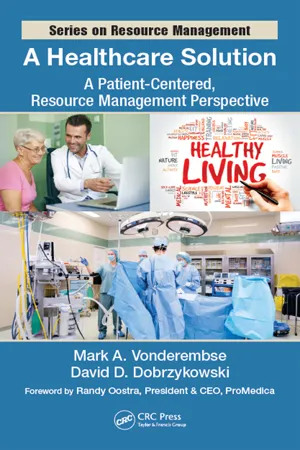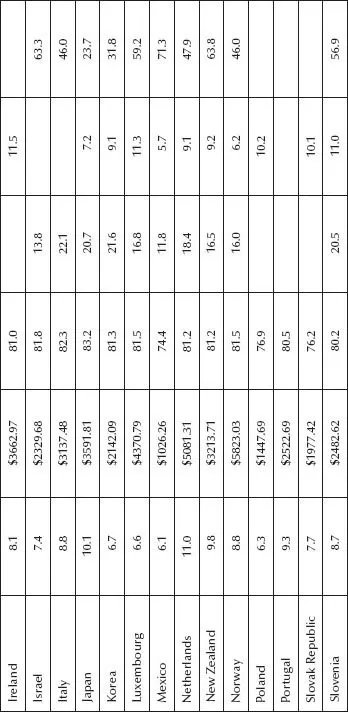![]()
Chapter 1
Healthcare: Where Do We Stand?
Healthcare in the United States is like A Tale of Two Cities. What people see depends on where they look and what they are looking for. With respect to creating new medical devices and procedures, doing research on deoxyribonucleic acid (DNA), developing pharmaceutical drugs, and other technical innovations, the United States leads the world. But in the execution and delivery of healthcare services, the United States has the highest cost in the world by far, and its health outcomes, such as longevity, are middle of the pack at best. This narrative examines the problems that explain this dichotomy between spending and outcomes. More importantly, it offers a comprehensive solution that should improve people’s health, ensure healthcare dollars are spent wisely, and enhance the performance of the healthcare delivery system. Before getting started, some definitions are appropriate:
1. Health is the overall condition of a person’s body and mind, and good health is a state of physical and mental well-being. It is not simply the absence of disease or infirmity. Someone in good health would have a good quality of life and longevity.
2. Healthcare is a set of actions or services that promote healthy living, prevent disease and infirmity, and diagnose and treat medical problems.
3. Healthcare delivery system is the people and organizations that must work in harmony to provide healthcare.
Try to imagine how health would suffer and how much healthcare would cost if advances in medical technology had not taken place, such as laparoscopic surgeries that are less invasive and stents used in arteries to keep blood flowing to the heart. Laparoscopic surgeries decrease surgical time, reduce complications, shorten or eliminate hospital stays, and shrink recovery time. Stents can be inserted in 30 minutes or less and have dramatically reduced the need for coronary bypass surgery, which is more complex, more costly, and has greater risks. Table 1.1 contains a set of activities that are part of medical technology, where the United States excels, as well as a list of important participants in delivering healthcare, which is the focus of this book.
Improving health and healthcare delivery begins by understanding the underlying problems and their root causes. With this knowledge, it is possible to develop and implement a solution that make a difference—a big difference—in the quality, availability, and cost of healthcare. The solution requires a focus on being healthy; rethinking how to organize, manage, and pay for healthcare; and understanding what adds value for patients and what does not. The solution is not a single idea, technique, or process change. It is a group of common-sense, easy-to-understand actions that address different aspects of healthcare, and are discussed in detail in subsequent chapters.
If there is an overriding theme to the changes, it is to put patients in charge, commonly call patient-centered care, which is more than asking patients how they feel. It is about placing them in a position to make informed decisions, that is, putting them in control. It is about personal responsibility, when patients, supported by their physicians, become custodians of their health and their healthcare.
The intent of the book is to present a comprehensive set of changes that will drive dramatic improvement in the health of the U.S. population and the performance of the healthcare delivery system. If these two goals can be achieved, it should be possible to extend high-quality care to those who currently do not have it while spending the same total amount on healthcare, possibly less.
Table 1.1 Elements of Medical Technology and Healthcare Delivery
Medical Technology Includes | Healthcare Delivery Includes |
| • Medical device design • Surgical procedure innovations • Pharmaceuticals development • Applied research, such as human genome • Medical simulation for diagnosis and treatment • Medical education advances | • Patients • Primary care physicians and physician specialists • Other medical and health professionals • Pharmacists and pharmacies • Hospitals and clinics • Testing and lab facilities • Information services providers • Third-party payer, insurers and employers |
1.1 The Healthcare Problem
A perception held by many is that healthcare in the United States is not working—costs are too high, and outcomes are less than they should be. It often takes too long to have a health problem diagnosed and treated, and people, even some who have health insurance, do not have access to the care they need.1 There are several important benefits to be had from achieving better health and improving the healthcare delivery system:
1. People should need less care, have a better quality of life, and enjoy greater longevity.
2. More resources should be available to treat people who currently have limited access to care and to invest in other worthwhile activities, such as cancer research or safer automobiles.
3. When healthcare costs are lower, U.S. businesses become more competitive globally because their healthcare costs are in line with their international competitors.
1.1.1 Healthcare Costs
The scope of the problem is enormous. According to the Center for Medicare and Medicaid Services (CMS), the United States spent about 17.2% of its gross domestic product (GDP) on healthcare in 2012,2 making it the largest sector in the U.S. economy. This is much higher, more than 50% higher, than other developed countries as reported by the Organisation for Economic Co-operation and Development (OECD), including France (10.8% of GDP), Germany (10.8%), Canada (10.2%), Japan (10.1%), and the United Kingdom (8.5%). Israel and Korea spent only 7.4% and 6.7% of the GDP on healthcare, respectively, so the United States spent more than twice the rate for these developed countries. Tied for second place were the Netherlands and Switzerland at 11.0%. As a percentage of the GDP, the United States spent at nearly twice the rate as the overall average for OECD countries, which was 8.9%.3 For more details, see the data in Table 1.2.
When healthcare spending is examined on a per capita basis, the United States spent $8917 per person in 2012 ($2.8 trillion in medical expenses2 with a U.S. population of 314 million4). That is more than 2.5 times the OECD average, which was $3389.30 measured in U.S. dollars (USD). In USD, France spent $4045.14, Germany spent $4693.27, Canada spent $4304.44, Japan spent $3591.81, and the United Kingdom spent $3175.48. Switzerland was second in per capita spending at $6140.46. See Table 1.2 for more data.3 Caveats about data used in the book, including different numbers reported by different sources, are described in Appendix B.
Spending more on healthcare should be a good thing if health outcomes, such as life expectancy, are better. This is not the case. OECD lists the “at-birth” longevity of the U.S. population at 78.8 years in 2012, which is 1.4 years less than the OECD average. The United States is behind Slovenia (80.2 years), which spent $2482.62 per person—about 75% less than the United States. U.S. longevity is slightly better than that of Chile (78.7 years) and the Czech Republic (78.2 years), which spent $1475.89 and $2021.46 per person, respectively. The only other countries in the OECD report that are behind the United States are Estonia (76.5 years), Hungary (75.2 years), Mexico (74.4 years), Poland (76.9 years), the Slovak Republic (76.2 years), and Turkey (74.6 years).5 All spent much less per capita on healthcare than the United States. More information is available in Table 1.2.
Table 1.2 OECD Health-Related Data from 2012
Source: Organisation for Economic Co-operation and Development (OECD). 2012. Health resources. https://data.oecd.org/healthres/health-spending.htm (accessed November 27, 2015).
1.1.2 Healthcare Quality and Outcomes
The Centers for Disease Control and Prevention (CDC) has defined and is attempting to assess health-related quality of life (HRQOL), which is a multidimensional measure of physical and mental health, including health conditions and risks, functional status, social support, and socioeconomic status.6 A study by Salomon et al. (2009) used four national U.S. health surveys to assess HRQOL: (a) Behavioral Risk Factor Surveillance System (BRFSS), (b) the Current Population Survey (CPS), (c) the National Health Interview Survey (NHIS), and (d) the National Health and Nutrition Examination Survey (NHANES). For the three surveys with annual data (BRFSS, CPS, and NHIS), the following results were found in the United States for the period 1998 to 2007 using a five-point scale to rate HRQOL (excellent, very good, good, fair, or poor).
1. For men and women, there were declines in excellent ratings for all three surveys.
2. For men, there were significant increases in the number of fair or poor ratings in the BRFSS, but there were significant declines in fair and poor ratings in the CPS. The increase in the number of fair or poor ratings for the NHIS was not statistically significant.
3. For women, there were significant increases in fair and poor ratings for BRFSS and CPS.
The data from the different surveys offer some useful insights. Over time fewer people, both men and women, believe that their HRQOL is excellent. More women feel that their HRQOL is fair or poor. For men, these results were mixed. Overall, it seems that the HRQOL in the United States declined from 1998 to 2007.7
Another aspect of healthcare quality is the frequency of hospital-acquired infections or nosocomial infections. As reported by the CDC, the United States had approximately 722,000 nosocomial infections in 2011, which resulted in about 75,000 deaths.8 Not only do nosocomial infections impact longevity and quality of care, they cost billions of dollars to treat, thereby driving up healthcare costs.
It is most likely that the underperformances in longevity and quality of life are not caused by differences in tobacco use or alcohol consumption because the United States is a below-average user of these substances when compared to other countries in the OECD. Table 1.2 shows that only 14.2% of the United States’ population 15 years and older are daily tobacco users compared to 18.8% in OECD countries who have reported these data.9 The annual per capita consumption of alcohol per persons 15 years and older is 8.8 liters compared to 9.3 liters for OECD countries.10
However, the United States is near the top in obesity as measured by the body mass index (BMI). According to the OECD data in Table 1.2, 68.6% of the U.S. population is either overweight (a BMI of more than 25) or obese (a BMI of more than 30).11 This is the second highest percentage among countries reporting the data, behind only Mexico at 71.3%. Without digging too deeply into statistics, it is useful to note that Mexico has the highest percentage of overweight people and the shortest longevity at 74.4 years. Japan, with the lowest percentage of overweight people at 23.7% has the greatest longevity at 83.2 years. The United States, which spends the most on healthcare by far, has the second highest percentage of overweight people and a longevity that is 1.4 years below the average.
As many people are aware, health in the United States is in serious danger from obesity and its resulting diseases. The negative impacts of obesity on healthcare costs as well as longevity and quality of life are substantial—reaching epidemic proportions. Left unchecked, this epidemic is likely to lead to more negative consequences than smoking, drug abuse, or alcohol consumption.
The United States spends more on healthcare, by a wide margin both as a percentage of GDP and per capita, than other developed countries, and U.S. health-related outcomes are middle of the pack or less. Although this discrepancy between spending and outcomes is caused, in part, by lifestyle choices, the discrepancy also indicates that the U.S. healthcare delivery system may be inefficient and prone to error. As the root causes and solutions to the underlying healthcare problems are discussed in future chapters, these possibilities are examined.
1.1.3 Delays and Limits to Access
There are delays in the healthcare delivery system that prevent patients from getting problems diagnosed and treated in a timely manner. How would U.S. consumers react if they had to wait several days to get an appo...



